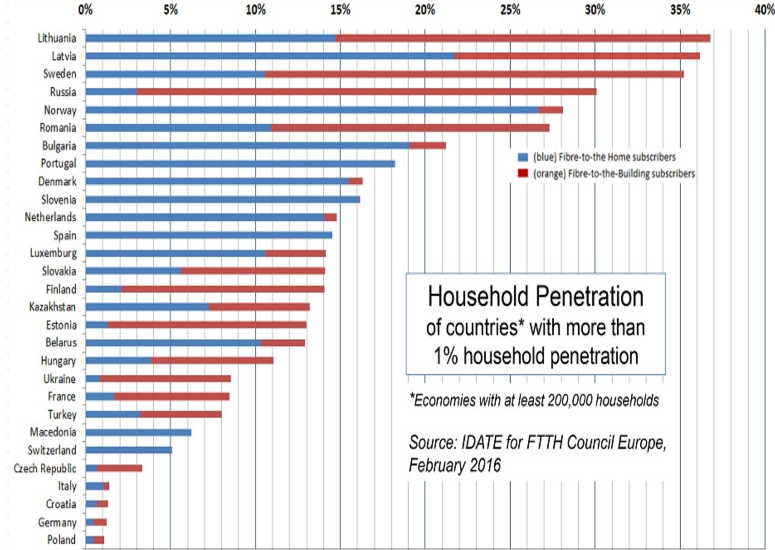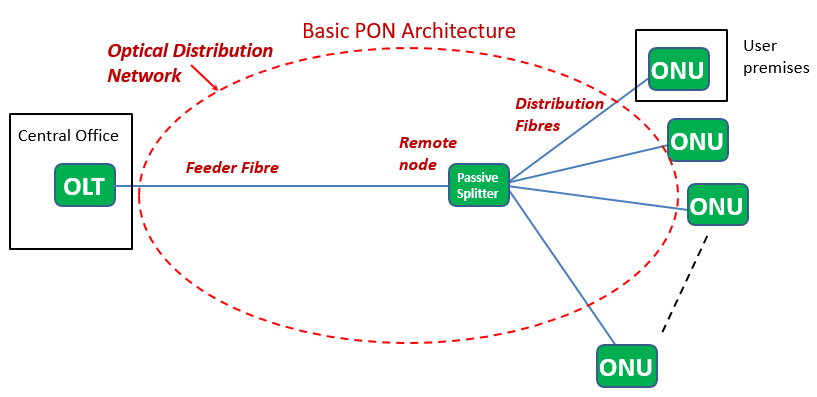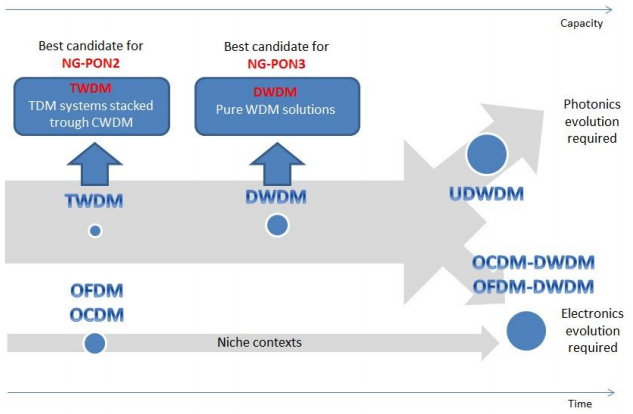-
Paper Information
- Paper Submission
-
Journal Information
- About This Journal
- Editorial Board
- Current Issue
- Archive
- Author Guidelines
- Contact Us
Journal of Wireless Networking and Communications
p-ISSN: 2167-7328 e-ISSN: 2167-7336
2017; 7(2): 35-40
doi:10.5923/j.jwnc.20170702.02

Current and Future FTTH Technologies
Hebah Alobaidan
Switching Department of the Higher Institute of Telecommunication & Navigation, PAAET, Kuwait
Correspondence to: Hebah Alobaidan, Switching Department of the Higher Institute of Telecommunication & Navigation, PAAET, Kuwait.
| Email: |  |
Copyright © 2017 Scientific & Academic Publishing. All Rights Reserved.
This work is licensed under the Creative Commons Attribution International License (CC BY).
http://creativecommons.org/licenses/by/4.0/

Optical Communication has grown to become a popular technology used in networking and data transmission. The implementation of optical networks has reached a global scale, and is now available in most countries. This is due to the wide range of benefits that can be achieved with optical networks. The most common implemented optical network is the passive optical network (PONs), which allows achieving the great benefits of an optical network, but at lower costs. PONs enabled the deployment of modern Fibre to the Home (FTTH) networks, which are now considered advanced access technologies compared to traditional DSL networks. This report discusses the wide implementation of PONs and their different types. It also introduces the differences among such networks, and where one excels over the other. Furthermore, it discusses the underlining challenges of current and future network access technologies. Finally, it provides an insight on the promising future techniques for FTTH access networks.
Keywords: Optical communication, Optical Networks, PONs, EPON, GPON, 10G-EPON
Cite this paper: Hebah Alobaidan, Current and Future FTTH Technologies, Journal of Wireless Networking and Communications, Vol. 7 No. 2, 2017, pp. 35-40. doi: 10.5923/j.jwnc.20170702.02.
Article Outline
1. Introduction
- Internet service providers (ISPs) have been continuously chasing after the demand for higher bandwidth and data throughput. Over time ISPs, have migrated their services from UTP networks towards Optical network. This is due to several advantages that optical networks have over copper networks, as a result of the different medium used in the physical data link layer. Optical networks transmit information over an optical link, which resulted in multiple advantages over electrical transmission. As a result of the advantages noted in fibre optical networks, it led to the wide deployment of Fibre Optic networks on a global scale. Optical fibre largely replaced copper wire communications in core networks in the developed world. Optical fibre is currently being deployed even closer to the user’s property (FTTH), due to the following advantages [1-4]:Ÿ Network future proofingŸ Maximises the symmetrical bandwidth throughput Ÿ Provides for improved network reliability Ÿ reduces operating expenses Ÿ Affords enhanced revenue opportunities. Ÿ Optical fibre has no electromagnetic interferenceŸ Optical fibre is very light weight Ÿ Optical fibre is such small in size.ISPs are forced to accommodate the increase of bandwidth requirements, as new services deployed on a global scale tend to gradually require more bandwidth. It is expected that within 5 years, users will need 1 Gbps links. This is to accommodate services such as HDTV, TVOD, 3DTV, Online Gaming, Cloud platforms, File sharing, the overall increase of internet demanding devices and internet usage [2]. Fibre-to-the-x (FTTx) is where fibre is brought closer to the end user. How close fibre goes to the end user depends on the type of architecture used, hence the use of the variable x, which is used to explain that there are several versions of architectures that can be used. Fibre can be deliver to the end user’s home, curb, building, premises, desk and neighbourhood. There are several architectures such as fibre-to-the-home (FTTH), fibre-to-the-curb (FTTC), fibre-to-the-building (FTTB), fibre-to-the-neighbourhood (FTTN), fibre-to-the-office (FTTO) and fibre-to-the-premises (FTTP). In this report, FTTH is our main interest and it stands for Fibre-to-the-home; this architecture connects a fibre link from the central office (CO) to the end user’s home. The fibre in this architecture runs up to the individual’s home or apartment, delivering maximum fibre deployment with no copper connections in between that may act as a bottleneck, resulting in a high bandwidth. Figure 1 shows the wide deployment of FTTH networks world-wide.
 | Figure 1. Shows the deployment of FTTH deployments |
2. PONs
- Passive optical networks are the most suitable network architectures, as they address cost issues in P2P networks and Active Star Networks also known as Active Optical Network (AON). A P2P Architecture is where a fibre cable is deployed from the Central Office to the end user. Simple, yet costly as it requires a great amount of fibre cable termination. An AON architecture on the other hand, provides an active node which dramatically reduces the fibre deployment, yet due to the increased number of links the transceivers are increased as well. The node in an active star is an active node which needs power to function and back-up power in case of a power failure. In addition, it requires cooling and it requires space. Due to its requirements and maintenance it is still considered costly [5]. A PON, has several advantages over P2P and AON. A PON is an optical fibre network that only uses fibre and passive components. PONs are used to deliver FTTx deployments and are considered the most popular FTTx architecture due to their simplicity and their lower costs compared to P2P and AON, as they are considered less costly compared to P2P and AON [2]. A PON consists of 3 major parts; an Optical Line Termination (OLT) an Optical Splitter/ Combiner and an Optical Network Unit (ONU). The OLT is at the Internet Service Provider’s (ISP) side and a number of Optical Network Units (ONUs) are located on the end user’s side, with the Optical Splitter in between the two. Typically, up to 32 ONUs can be connected to an OLT, this depends on the technology used and on the range the network is required to work. Figure 2 shows a PON architecture. A PON architecture has the following advantages:
 | Figure 2. Shows a PON architecture [2] |
3. Current & Future Access Technologies
- There are several types of PON systems, which have been deployed over the past years as access technologies. Such access technologies are; APON, BPON, EPON, GPON, 10G EPON, and Next-generation PON1 (NG-PON1). In this section of the report, access technologies will be reviewed.1. Asynchronous PON (APON)The first generation of the PON series was standardised by the ITU-T full-service access network (FSAN) group in mid 1990s. This was to explore the end-to-end ATM connection based on a point-to-multipoint tree configuration. Using ATM protocol at first was accepted, as ATM Protocol is the main protocol for telephone networks and also used for data transfer. APON networks support 32 subscribers with a single upstream data rate of 155 Mbps and downstream data rate of 622 or 155 Mbps (Asymmetric). As defined in the IEEE 802.3 family, the maximum data rate in APON was 622 Mbps to 1.244 Gbps [7-10]. 2. Broadband PON (BPON)Broadband PON (BPON) as defined in ITU-T G.983 series, was a further improvement of the APON. The objective of BPON was to achieve cost effective deployment of broadband optical access systems. BPON offers numerous broadband services including ATM, Ethernet access, and video distribution. BPON uses ATM as the same signalling and transport protocol, similarly to APON. However, BPON also provides enhanced security. Another significant difference between APON and BPON is that BPON allowed video distribution while APON did not focus on video. BPON made more sophisticated use of WDM by adding additional wavelengths for video distribution. BPON digital signals operate at ATM rates of 155, 622 and 1244 Mbps [10]. 3. Ethernet PON (EPON)Ethernet PON is an IEEE standard (IEEE 802.3.ah). EPON uses Ethernet frames for data transmission and enables seamless integration with IP and Ethernet technologies. As a result of EPONs fine scalability, simplicity, suitability, and the capability of providing full service access. In addition to EPON’s protection of the Ethernet framing format, which carries variable length packets without destruction, EPON became one of the most implemented PON technologies. EPON operates at 1.25Gbps in the upstream direction and 1.25Gbps in the downstream direction (symmetric) with a maximum distance of 20 km and 32 splits [10-11].4. 10G-EPONThis is also known as the IEEE 802.3av standard, which was finally issued in 2009. It increases the data rate of EPON system from 1Gbps to 10Gbps. It also inherits the EPON’s MPCP protocol, while it focuses on the physical layer. The IEEE 802.3av standard’s main requirements were, the increase of the data rates to 10 Gbps and that the new standard can coexist with the previous version of EPON (802.3.ah) in the same ODN network, allowing upgrades to be performed in a less complex manner The 10G-EPON benefits from a symmetric performance, where upstream and downstream are both 10 Gbps. It also benefits from an asymmetric structure, where upstream is 1Gbps on the same 1310 nm wavelength and downstream is 10 Gbps on the 1270 nm wavelength [12, 13].5. Gigabit PON (GPON)Gigabit PON (GPON) supports a symmetrical data rate of 2.488 Gbps in both downstream and upstream. It supports the transport of Ethernet, ATM and TDM, providing strong Operation Administration, Maintenance, and Provisioning (OAM&P) capabilities, offering end-to-end service management. GPON provides a greater bandwidth and range compared to APON, BPON and EPON, using GEM Encapsulation. GPON is a close competitor of EPON, where some countries prefer their FTTx deployments to be in the EPON architecture others prefer GPON [10, 14]. 6. OFDM PONOrthogonal frequency division multiplexing (OFDM) PON has received a great amount of attention due to its advantages such as resistance to inter symbol interference (ISI). It utilises OFDM as the modulation scheme to increase the data rate. This type of PON uses OFDMA as an access scheme, where it divides both streams of bandwidth into multiple subcarriers with orthogonal frequencies. It modulates the subcarriers using Fast Fourier Transform (FFT) and Inverse Fast Fourier Transform (IFFT). ONUs are allocated with their subcarriers based on their real-time incoming traffic. OFDM PONs overcomes the previously mentioned PONs with multiple advantages such as high speed transmission, fine granularity of bandwidth allocation, and colour-free ONUs. OFDM has the potential capability to increase transmission rate and range without the increase in complexity and cost [17].7. Next Generation-PONFSAN and ITU-T defined that Next Generation PONs will have to offer low costs, large capacity, wide coverage, full service, and interoperability with existing technology. The NG PONs were split into two phases, which were NG-PON1 and NG-PON 2. NG-PON1 phase was defined as a mid-term solution that would be compatible with current technologies while NGPON2 was defined as a long term solution independent of existing technologies. NG-PON1 specifies both asymmetric and symmetric 10Gbps. The 10G-EPON is an example of the NG-PON1 technology. Another example is the ITU-T G.987 standard, also known as XG-PON. The 10G-PON is a networking standard for data links, capable of delivering shared Internet access rates up to 10 Gbps and 2.5 Gbps upstream. XG-PONs are the ITU-T's next generation standard following on from G-PON. Another enhancement to GPON was the XG-PON2, which has a symmetric rate of 10 Gbps [15, 16].
4. Challenges
- Optical networks are receiving a great amount of attention to tackle the challenges and obstacles in their progress. There are several challenges that need to be dealt with in order to enhance current performance and to assure the stability of future optical access network. Such challenges are [18]: 1. EPON and GPON SecuritySince data is transferred to all ONUs, it can cause the wrong information to reach the unintended person. There are security mechanisms in place, but there is still a large chance of eavesdropping 2. CostThe deployment of optical networks is considered costly, due to the costs of the optical devices involved in an optical network. Optical amplifiers, ONUs and Optical splitters are required to be less costly, in order to support cost effective PONs.
 | Figure 3. Shows the data format of (a) BPON (b) GPON (c) EPON [14] |
5. Promising Future Techniques
- Several studies claimed that WDM, DWDM, UDWDM and OFDM are techniques that will enable NG-PON2 and NG-PON3 networks to emerge. As shown in Figure 4, such techniques are considered for long term access networks. Wavelength Division Multiplexing technique is an aspirant solution for next-generation PON systems. The introduction of WDM in PONs provides an increase in bandwidth and provides improvements for future generation PONs. Through the implementation of A WDM-PON, a logical P2P link of one or two wavelengths is established to each user. It allows a symmetric, with reserved bandwidth, minimum bandwidth guarantee, simplified techniques to provide network security and transparency to modulation formats and bitrate [21].
 | Figure 4. Shows an evolutionary roadmap of PON technologies [25] |
6. Conclusions
- This report discussed the current access technologies and the future access technologies. It also provided an insight on the future technologies that will aid in the development of such access networks. As NG-PON1 systems are already deployed, NG-PON2 and NG-PON3 systems are receiving continuous attention from researchers and institutes. Until now, it is speculated that the main technologies to participate in NG-PON2 and NG-PON3 are WDM, DWDM and OOFDMA for their promising advantages that were outlined in this report. Such technologies will play a key enabling role in the future of optical communication.
 Abstract
Abstract Reference
Reference Full-Text PDF
Full-Text PDF Full-text HTML
Full-text HTML